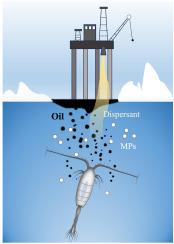当前位置:
X-MOL 学术
›
Environ. Pollut.
›
论文详情
Our official English website, www.x-mol.net, welcomes your
feedback! (Note: you will need to create a separate account there.)
Sublethal effects of microplastic and oil co-exposure on biological rates and lipid profiles of keystone Arctic copepods
Environmental Pollution ( IF 7.6 ) Pub Date : 2024-11-09 , DOI: 10.1016/j.envpol.2024.125286 R. Almeda, R. Rodriguez-Torres, S. Rist, M. Winding, S. Jonasdottir, T. Gissel Nielsen
Environmental Pollution ( IF 7.6 ) Pub Date : 2024-11-09 , DOI: 10.1016/j.envpol.2024.125286 R. Almeda, R. Rodriguez-Torres, S. Rist, M. Winding, S. Jonasdottir, T. Gissel Nielsen

|
Microplastics (MPs) and petroleum hydrocarbons are contaminants of emerging concern in the Arctic, but little is known about their co-exposure effects. In this study, we present the first assessment of the sublethal impacts resulting from combined exposure to microplastics and oil in three key Arctic copepod species. Specifically, we investigated the effects of a 5-day exposure to oil alone (1 μL L−1) and in combination with MPs (polyethylene microspheres, 20 μm, 20 MP mL−1) and dispersant (Corexit 9500, 0.05 μL L−1) on the biological functions and lipid profiles of the planktonic copepods Metridia longa, Calanus finmarchicus, and Calanus glacialis. Exposure to oil alone caused a significant reduction (34–58%) in fecal pellet production, but neither microplastics nor dispersant increased the negative effect of oil on fecal pellet production. C. glacialis and C. finmarchicus exposed to the studied pollutants for 5 days produced eggs with delayed hatching and lower hatching success. The highest hatching inhibition (50%) was observed in eggs of C. glacialis exposed to oil plus MPs and dispersant for five days. This indicates that maternal transfer of oil components to eggs negatively affects embryonic development and hatching. Lipid content and fatty acids profiles varied among the studied copepod species but were not affected by the tested pollutants after five days of exposure. By microscopical observation of fecal pellets, ingestion of small oil droplets and MPs was confirmed in all species, but the estimated ingestion of MPs was low (<25 MPs cop−1 d−1, <0.2% of total offered MPs) suggesting avoidance of MP consumption in copepods. Our results indicate that virgin MPs did not increase the toxicity of oil to the studied Arctic copepods under co-exposure conditions, and dispersants can slightly increase certain adverse effects of oil (hatching). However, environmentally relevant concentrations of oil alone can negatively impact Arctic keystone copepods and potentially the biological carbon pump. These findings emphasize the need to reduce petrogenic pollution and the risk of oil spills in the sensitive Arctic ecosystem.
中文翻译:

微塑料和石油共同暴露对北极桡足类动物生物速率和脂质谱的亚致死影响
微塑料 (MP) 和石油烃是北极日益受到关注的污染物,但人们对它们的共同暴露效应知之甚少。在这项研究中,我们首次评估了三种主要北极桡足类物种联合暴露于微塑料和石油造成的亚致死影响。具体来说,我们研究了单独暴露于油中 5 天 (1 μL L-1) 以及与 MP(聚乙烯微球,20 μm,20 MP mL-1)和分散剂 (Corexit 9500,0.05 μL -1) 的组合对浮游桡足类 Metridia longa、Calanus finmarchicus 和 Calanus glacialis 的生物学功能和脂质谱的影响.单独接触油会导致粪便颗粒的产生显着减少 (34-58%),但微塑料和分散剂都没有增加油对粪便颗粒产生的负面影响。C. glacialis 和 C. finmarchicus 暴露于研究污染物 5 天后,产生的卵孵化延迟且孵化成功率较低。在暴露于油、MPS 和分散剂 5 天的冰川梭菌卵中观察到最高的孵化抑制 (50%)。这表明母体将油成分转移到鸡蛋上会对胚胎发育和孵化产生负面影响。脂质含量和脂肪酸谱在研究的桡足类物种之间有所不同,但在暴露 5 天后不受测试污染物的影响。通过对粪便颗粒的显微镜观察,所有物种都证实了小油滴和 MP 的摄入,但估计的 MP 摄入量较低(<25 MPS cop-1 d-1,<0.2% 占提供的总 MP),表明避免在桡足类中消耗 MP。 我们的结果表明,在共暴露条件下,原始 MPS 不会增加石油对所研究的北极桡足类的毒性,分散剂会略微增加石油的某些不利影响(孵化)。然而,仅与环境相关的石油浓度就会对北极基石桡足类和潜在的生物碳泵产生负面影响。这些发现强调了减少敏感北极生态系统中石油成因污染和石油泄漏风险的必要性。
更新日期:2024-11-12
中文翻译:

微塑料和石油共同暴露对北极桡足类动物生物速率和脂质谱的亚致死影响
微塑料 (MP) 和石油烃是北极日益受到关注的污染物,但人们对它们的共同暴露效应知之甚少。在这项研究中,我们首次评估了三种主要北极桡足类物种联合暴露于微塑料和石油造成的亚致死影响。具体来说,我们研究了单独暴露于油中 5 天 (1 μL L-1) 以及与 MP(聚乙烯微球,20 μm,20 MP mL-1)和分散剂 (Corexit 9500,0.05 μL -1) 的组合对浮游桡足类 Metridia longa、Calanus finmarchicus 和 Calanus glacialis 的生物学功能和脂质谱的影响.单独接触油会导致粪便颗粒的产生显着减少 (34-58%),但微塑料和分散剂都没有增加油对粪便颗粒产生的负面影响。C. glacialis 和 C. finmarchicus 暴露于研究污染物 5 天后,产生的卵孵化延迟且孵化成功率较低。在暴露于油、MPS 和分散剂 5 天的冰川梭菌卵中观察到最高的孵化抑制 (50%)。这表明母体将油成分转移到鸡蛋上会对胚胎发育和孵化产生负面影响。脂质含量和脂肪酸谱在研究的桡足类物种之间有所不同,但在暴露 5 天后不受测试污染物的影响。通过对粪便颗粒的显微镜观察,所有物种都证实了小油滴和 MP 的摄入,但估计的 MP 摄入量较低(<25 MPS cop-1 d-1,<0.2% 占提供的总 MP),表明避免在桡足类中消耗 MP。 我们的结果表明,在共暴露条件下,原始 MPS 不会增加石油对所研究的北极桡足类的毒性,分散剂会略微增加石油的某些不利影响(孵化)。然而,仅与环境相关的石油浓度就会对北极基石桡足类和潜在的生物碳泵产生负面影响。这些发现强调了减少敏感北极生态系统中石油成因污染和石油泄漏风险的必要性。


















































 京公网安备 11010802027423号
京公网安备 11010802027423号